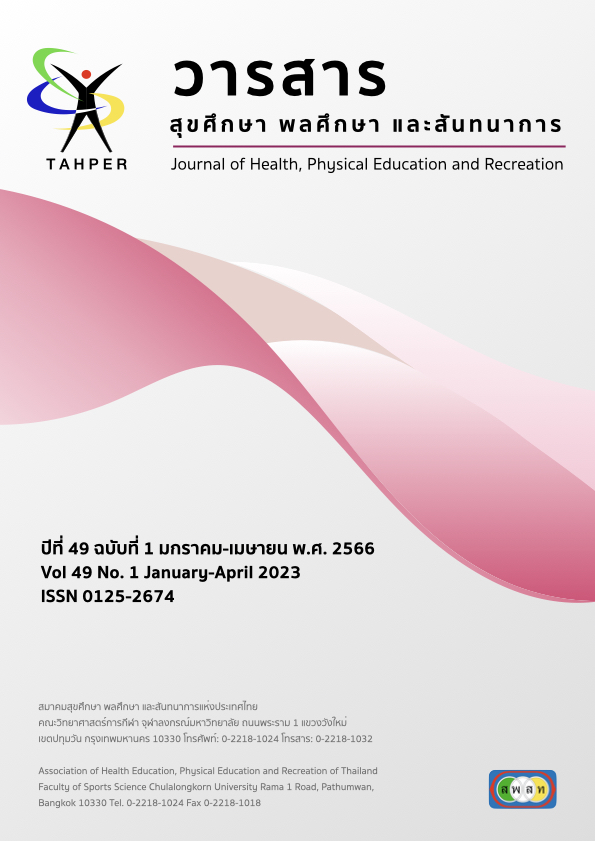Comparison of Ballistic and Plyometric Training on Softball Speed Ball and Physical Fitness
Main Article Content
Abstract
The aim of this research was to study and compare the effects of ballistic and plyometric training on softball speed ball and physical fitness (power, speed, and agility). Twenty amateur softball players (ages 14-17)from Kasetsart University Laboratory School Kamphaeng Saen Campus Center for Educational Research and Development participated in the study. The participants were divided into two group of 10 each (equal number of males and females per group).The ballistic and plyometric training programs were six weeks long, with 3 days/week training sessions. All the participants were tested on softball speed ball, power, speed, and agility.The data were analyzed using the mean, standard deviation, independent and dependent t-tests. Significance level was set at 0.05.
The results showed no significant between-group differences in softball speed ball and physical fitness tests between the ballistic and plyometric six-week training programs. However, there were some significant within-group differences. For example, the ballistic training program showed significant increases in softball speed ball, but no significant improvement in power, speed, and agility. The plyometric training program showed significant increases in softball speed ball and power.
This study found that both ballistic and plyometric training programs improved softball speed ball, but did not show much improvement on power, speed, and agility.
Article Details

This work is licensed under a Creative Commons Attribution-NonCommercial-NoDerivatives 4.0 International License.
Critical thinking in journals is the right of the author. The Association of Health Education, Physical Education and Recreation of Thailand is not always required, to create diversity in ideas and creativity.
ความคิด ข้อวิพากษ์ในวารสารเป้นสิทธิของผู้เขียน สมาคมสุขศึกษา พลศึกษา และสันทนาการแห่งประเทศไทยไม่จำเป็นต้องเห็นชอบด้วยเสมอไป เพื่อให้เกิดความหลากหลายในความคิดและความสร้างสรรค์
References
Andrew B. Carter, Thomas W. Kaminski, AL T douex jr, Christopher A. knight, and James G. richards. (2007). Effect of hight volume upper extremity plyometric training on throwing velocity and functional strength ratios of the shoulder rotators in collegiate baseball players. Journal of Strength and Conditioning Research, 21(1), 208–215.
Benesh, T.A. 1989. Comparison of two plyometric techniques. Dissertation abstracts international. Coleman, A. Eugene. (2000). Baseball, physical fitness. Champaign, IL: Human kinetics.
Chu, Donald and Gregory D. Myer. (2013). Plyometrics. Human Kinetics, USA.
Chu, Donald and R. Panariello. (1989). Sport-specific plyometrics: Baseball pitching. NSCA Journal, 11(3), 81.
Eduardo Saez-Saez de Villarreal, Mikel Izquierdo, Juan Gonzalez. (2009). Determining variables of plyometric training for improving vertical jump height perfoermance, a meta-analysis. Journal of strength and conditioning research.
Fleck, Steven J. and Kraemer, Wiliam J. (2013). Ballistic training in designing resistance training programmes, Human Kinetics:Leeds.
George St. Ross. (1970). The psycholinguistic abilities of children from different ethnic backgrounds. Australian journal of psychology.
Jaime Fernandez-Fernandez, David sanz, Eduardo Saez de Villarreal, Manuel Moya. (2015). The effects of 8-week plyometric training on physical performance in young tennis players. Pediatric exercise science.
Jose Luis Hemandez-davo and Rafael Sabido. (2014). Rate of force development: reliability, improvements and influence on performance. European journal of human movement, 33, 46-69.
Keijo hakkinen, Robert Usher Newton, William J Kraemer. (1999). Effects of ballistic training on preseason preparation of elite volleyball players. Medicine and science in sports and exercise.
Kerry p. mcevoy and Robert u. Newton. (1998). Baseball throwing speed and base running speed: the effects of ballistic resistance training. Journal of Strength and Conditioning Research, 12(4), 216–221.
Lyttle, A. D., G. J. Wilson, K. J. Ostrowski. (1996). Enhancing performance: maximal power versus combined weights and plyometric training. Journal Strength and conditioning Research.
Marc O. Dagenais. (2007). Softball peak performance coach. M.O. Dagenais and Associates, Inc. Canada.
Nikolaos Zaras, Konstantinos Spengos, Spyridon Methenitis, Constantinos Papadopoulos, Giorgos Karampatsos, Giorgos Georgiadis, Aggeliki Stasinaki, Panagiota Manta, and Gerasimos Terzis. (2013). Effects of strength vs. ballistic-power training on throwing performance. Journal of sports science and medicine. 12(1): 130-137.
Paul E Luebbers, Jeffrey Pottelger, Matthew Hulver and John P Thyfault. (2003). Effect of plyometric training and recovery on vertical jump performance and anaerobic power. The journal of strength and conditioning research.
Schmidtbleicher, D. (1992). Training for power event. The encyclopeadia of sports medicine. Oxford, UK:Blackwell.
STOWERS, T., J. MCMILLAN, D. SCALA, V. DAVIS, D. WILSON, AND M. STONE. (1983). The short-term effects of three different strength-power training methods. Natl. Strength and conditioning journal, 5, 24-27.
Warren B Young and Damian Farrow. (2006). A review of agility: practical applications for strength and conditioning. Strength and conditioning journal.
Wathen, D. (1993). “Literature review: explosive/plyometric exercise.” National strength and conditioning association journal.


